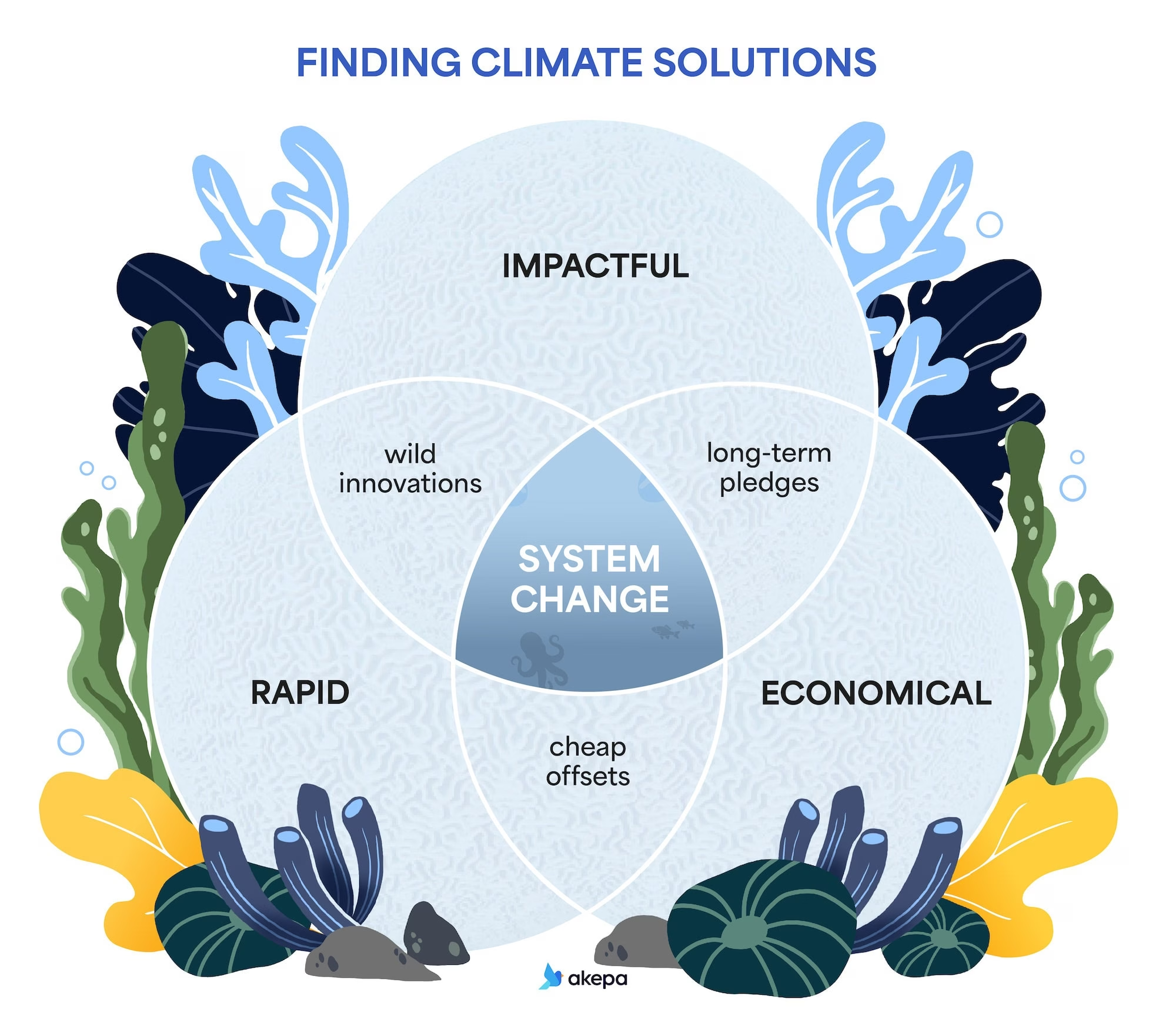Climate change is one of the most pressing challenges facing our collective wellbeing. As we search for solutions to engender an appealing future vs. an appalling one, it’s clear that no single approach is a cure-all.
A connected strategy is what’s needed – one that balances priorities. The Venn diagram in this post, titled “Finding Climate Solutions,” – upcycled from an original Akepa Linkedin post – pinpoints the need to find a balance among impactful, rapid, and economical solutions, with the goal of achieving systemic change.

The pillars of climate action: Impactful, Rapid & Economical
Forming this diagram / coral-reef are three key pillars that we think should be considered when developing climate solutions: Impactful, Rapid, and Economical.
- Impactful Solutions: These are actions that lead to measurable reductions in greenhouse gas emissions or noticeable improvements in climate resilience. Impactful solutions may involve cutting-edge innovations or large-scale initiatives that bring about substantial change. However, these actions alone may be slow to implement or require intense resources, stressing the need to balance impact with feasibility.
- Rapid Solutions: Speed is sought-after in the fight against climate change. Rapid solutions are all about the need for quick wins – measures that can be implemented briskly to reduce emissions or adapt to climate impacts. However, the trade-off is that rapid solutions may not always be the most impactful in the long term and their costs can be prohibitive.
- Economical Solutions: When seeking the biggest impact, economics is not the enemy and must be considered. Solutions that are cost effective, can be more accessible and scalable. However, a cold approach focused on money often overlooks the depth of impact or the need for urgent action, leading to solutions that fall short in the long run.
Challenges at the periphery
The diagram also highlights three areas that lie outside of the optimal intersection, each home to its own set of challenges when leaning too heavily in a few directions:
- Wild Innovations: When solutions are highly impactful but lack economic feasibility or rapid scalability, they could be what we call “wild innovations.” These might be groundbreaking technologies or ambitious projects that could revolutionize climate action, in theory. But they face hurdles in terms of cost or speed of roll-outs. They risk becoming gimmicks that are only really accessible to an elite set of folk.
- Long-Term Pledges: Solutions that are impactful and economical but slow to implement are often those long-term pledges aiming at distant dates like 2050. These are commitments, such as net zero, made by governments or corporations to achieve significant results over decades. While important, and potentially impactful over the long-term, they lack the immediacy to address the urgent nature of the climate crisis. They are also often reneged upon.
- Cheap Offsets: On the other hand, actions that are rapid and economical but lack decent impact are those like the cheap and ubiquitous offsets that are used to present an ersatz veneer of climate action. These might involve buying carbon credits or other market-based solutions that offer quick, cheap results but may not lead to deep, systemic change. Such measures can be criticized for being superficial, failing to address the underlying issues. And in fact, some recent studies have suggested that not only does carbon offsetting not work but it can worsen the problem.
The intersection: System Change
At the center of the Venn diagram, where impactful, rapid, and economical solutions intersect, you’ll find System Change. This central sweet spot in climate action is where initiatives are not only effective and swift but also financially viable. Here, we see a transformation of our societal, economic, and environmental systems to a sustainable model.
System change involves rethinking the way things get done, shifting towards renewable energy, sustainable agriculture, and circular economies.
It requires not just technological advancements but also policy reforms, cultural shifts, and new economic models. Achieving system change means addressing the root causes of climate change rather than merely treating the symptoms.
Here are some ideas:
- Strengthening climate resilience in the countries that contribute the least to the climate crisis but face the most tumultuous effects.
- Fostering deeper relationships within our system, such as with Indigenous people who hold a lot of natural answers to the climate crisis and give the environment the reverence it deserves.
- Raising awareness of CH4 as well as CO2 – while reducing CH4 emissions by getting wonky and outdated infrastructural systems replaced – alongside legislation.
- Making sure that COP events, where decisive action should be taken, are not manipulated by the puppet-strings of fossil-fuel lobbyists.
In short, stuff that requires deep amounts of thought, ingenuity, dialogue and collaboration.
The rocky road ahead
Finding the finest climate solutions is tricky. You could say a strive for balance – where impactful, rapid, and economical solutions converge to power systemic change. As we stumble forward, trying to find our stride, it’s wise to recognize the limitations of focusing too narrowly on any single pillar. Instead, we must aim for comprehensive strategies that integrate these elements.
That in mind, system change is not just a goal but a shift from short-term fixes to long-lasting solutions that address the root causes of climate change. As we continue to innovate climate solutions, the focus must remain on achieving this fragile balance.
And you know what – this is of course all flawed, facile, and we know we don’t have the answers. Nevertheless, we hope our thoughts are helpful for someone, somewhere, in finding a little perspective, organizing their thoughts, or planning an impactful solution to climate change.



Leave a Reply